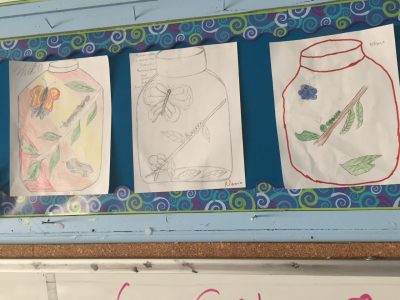
Students learned how to draw a jar using the oval shape and the art vocabulary words including pyramid, patterns, and symmetry.
ESL students learned basic vocabulary including the spelling of their colors and shapes.
This project theme was adaptable to all ages from preschool through high school was a great way to start the program. The metaphor encouraged students to be like caterpillars and absorb as much as “food for though” as possible so they can eventually take off to new worlds and transform like butterflies. Students learned the following vocabulary: leaf, tree branch, caterpillar, cocoon, jar, label, and lid. Students folded paper to make origami butterflies and decorated them with markers.
Students folded paper to make origami butterflies and decorated them with marker.
They learned about the migration of butterflies and the importance of butterflies and other pollinators in supporting plant that feed the entire world.
Students practiced symmetry by repeating the same pattern and colors mirrored on each wing.
Students learned that the markings on butterflies help us identify the species.
The large eye patterns also protect butterflies from predators.
Students liked hanging the artwork in their classrooms as a bright reminder of their goals and dreams.
In one classroom, we hung origami butterflies stapled to string across the room.
In another classroom, we twisted brown butcher paper to make branches of a tree and covered them with butterflies and paper flowers.
Our preschool students acted out migration flying around their classroom and then finally landing on the blackboard home in the US.